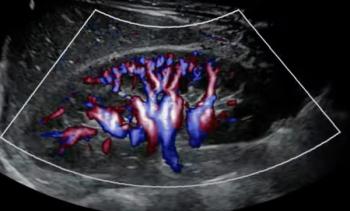
Philips seeks to mainstream 3T through MultiTransmit technology
Philips Healthcare executives believe the MultiTransmit parallel RF (radiofrequency) technology built into the company’s flagship 3T scanner will help make 3T a clinical workhorse.
Philips Healthcare executives believe the MultiTransmit parallel RF (radiofrequency) technology built into the company's flagship 3T scanner will help make 3T a clinical workhorse.
This technology, shown as a work-in-progress at RSNA 2008 and unveiled this year as a commercial product, overcomes two of the major challenges facing Philips' Achieva 3.0T TX: dielectric shading effects, which can obscure signs of disease from the neck to the hip, particularly cancer in the breast and liver, and limited scan speed due to tissue heating, as measured by specific absorption rate (SAR).
MultiTransmit parallel RF does this by adjusting multiple radiofrequency transmissions to the shape and size of each patient, effectively canceling out dielectric shading, according to Deepak Malhotra, vice president of Philips' MR marketing.
"With this next-generation technology, 3T is not just suited to neuro and musculoskeletal imaging," Malhotra said. "You can see the difference it makes in the clarity of (body) images. MultiTransmit makes 3T scanners into comprehensive clinical scanners."
The strength of MultiTransmit parallel RF is in its ability to adapt 3T scans to fit individual patients. The improvements afforded by the MultiTransmit technology, therefore, are attained under not only ideal circumstances.
"With 20 scans you will have 20 different patients with 20 different sizes and shapes," he said. "We're finding great improvement in uniformity and consistency of image quality from one patient to the next in breast and abdominal imaging."
Reducing dielectric shading opens the door for wider adoption of 3T as a sole source of MR imaging. Currently, most 3T installations have been at sites with other MR scanners, usually ones operating 1.5T systems. Although 3T excels at neuro and musculoskeletal imaging, shortcomings in its ability to image the body have limited the clinical utility of 3T scanners. MultiTransmit parallel RF solves this problem. This is especially important for oncological applications, as high-quality imaging of the body and breast is critically important when diagnosing and staging tumors.
Transmitting parallel RF energies also reduces SAR levels to the specific areas of the body being scanned. This cuts the amount of downtime between scans, trimming exams and increasing productivity.
"When you take SAR off the table, you can really hit the gas pedal," said Gene Saragnese, CEO of Imaging Systems at Philips Healthcare.
Early experience at beta sites indicates that MultiTransmit parallel RF can cut the time needed to perform 3T exams by up to 40%. These faster exams have the side benefit of requiring fewer patient retakes, which further improves productivity.
"We have seen a 20-minute overall scan drop to 13 minutes," said Malhotra, who noted that faster exams are especially important for pediatric patients.
One luminary at the University of Vermont told him that the MultiTransmit technology eliminated the need to administer anesthesia when doing pediatric abdominal scans.
This new technology began shipping onboard Achieva 3.0T TX systems in October. Going into the RSNA meeting, Philips had about 100 orders for new 3T scanners outfitted with the technology. Company executives expect to fill about 40 by year's end.
Increased efficiency and the broader clinical reach afforded by Philips' MultiTransmit technology promises to drive not only sales of new 3T systems but upgrade revenues as well. About 95% of Philips' 3T systems installed around the world are upgradable to MultiTransmit parallel RF.
Newsletter
Stay at the forefront of radiology with the Diagnostic Imaging newsletter, delivering the latest news, clinical insights, and imaging advancements for today’s radiologists.




























